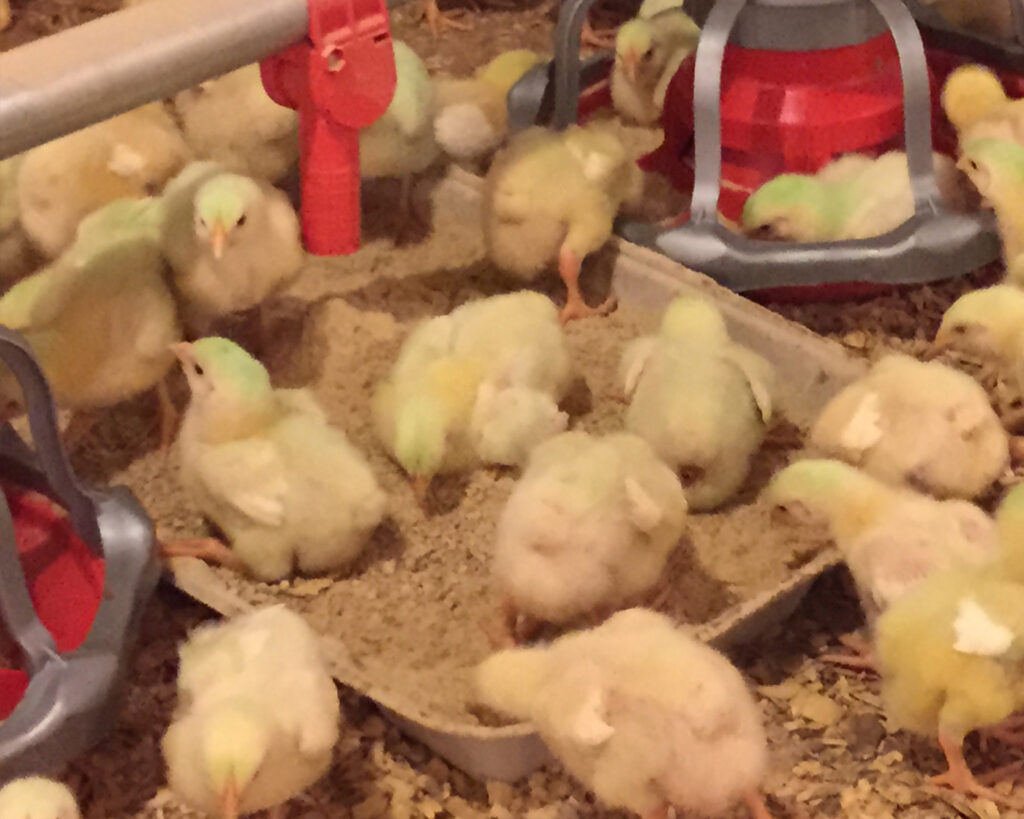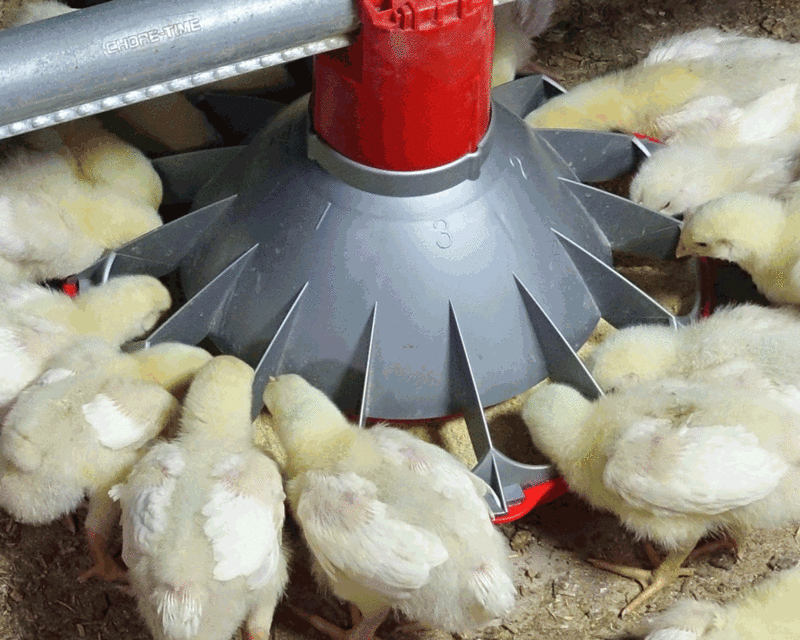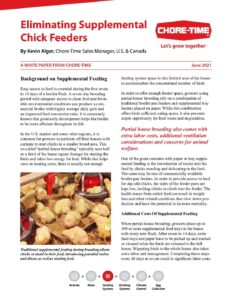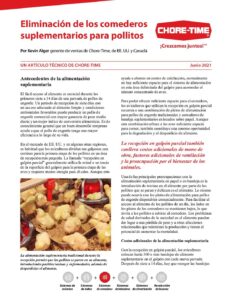White Paper:
Eliminating Supplemental Chick Feeders
Background on Supplemental Feeding
Easy access to feed is essential during the first seven to 14 days of a broiler flock. A seven-day brooding period with adequate access to clean feed and favorable environmental conditions can produce a commercial broiler with higher average daily gain and an improved feed conversion ratio. It is commonly known that good early development helps the broiler to be more efficient throughout its life.
In the U.S. market and some other regions, it is common for growers to partition off their houses with curtains to start chicks in a smaller brood area. This so-called “partial-house brooding” typically uses half or a third of the house square footage for starting the birds and takes less energy for heat. While this helps save on heating costs, there is usually not enough feeding system space in this limited area of the house to accommodate the concentrated number of birds.

In order to offer enough feeder space, growers using partial-house brooding rely on a combination of traditional broiler pan feeders and supplemental tray feeders placed on paper. While this combination offers birds sufficient eating space, it also presents ample opportunity for feed waste and degradation.
One of the great concerns with paper or tray supplemental feeding is the introduction of toxins into the feed by chicks standing and defecating in the feed. The same may be true of commercially available broiler pan feeders. In order to provide access to feed for day-old chicks, the sides of the feeder pans are kept low, inviting chicks to climb into the feeder. The health issues from soiled feed can result in weight loss and other related conditions that slow down production and have the potential to increase mortality.
Additional Costs of Supplemental Feeding
When partial-house brooding, growers place up to 300 or more supplemental feed trays in the house with every new flock. After seven to 14 days, extra feed trays and paper have to be picked up and trashed or cleaned when the birds are released to the full house. Migrating birds to the whole house also takes extra labor and management. Completing these steps every 48 days or so can result in significant labor costs.
Partial house brooding also comes with extra labor costs, additional ventilation considerations and concerns for animal welfare.
Because partial house brooding concentrates chicks into a smaller area of the house, the practice also tends to create higher levels of ammonia, requiring more air quality monitoring and ventilation. When minimum ventilation run times increase, so do electricity costs. This cancels some of the savings benefit from running heat in only a portion of the house with partial house brooding.
Feed space challenges, extra labor and ventilation, and concerns for animal welfare are reasons that help explain why whole-house brooding is a common practice in Europe and Canada, and why more United States poultry operations are considering a shift to whole-house brooding as well.
Eliminating Supplemental Feed With Whole-House Brooding
As more growers and integrators contemplate adopting the trend toward whole-house brooding, there are important considerations:

- To have enough feeder space without the costs and concerns that come with supplemental feeders, growers will likely need to add one feeder line to the house. All of the feeders in the house should be a feeder model that can effectively serve the eating needs of birds all the way from day-old through market weight.
- Growers can anticipate saving the costs associated with the purchase and handling of feeder paper and supplemental feeders.
- Feed conversion improvements should be expected due to the reduction in feed waste.
- Certain feeder designs also help reduce bird mortality due to the fact that chicks are not climbing into the feeder pans where they soil and contaminate the feed.
- By spreading the ammonia and moisture load out over the entire house, growers can reduce the minimum ventilation run time during the brooding period, as well as reducing litter caking.
- Growers will need to be prepared to heat the whole house.
Timing the Change to Whole-House Brooding Without Supplemental Feeders
The shift to whole-house brooding is gaining momentum. Retailers and restaurants such as Whole Foods, Costco and McDonald’s are meeting customer demand by encouraging suppliers to use animal welfare practices in mass production. This means giving birds more room to grow, more feeder space and cleaner feed. Some integrators are even instituting practices that allow birds to go outside or installing windows to provide more natural light.
Moving to whole-house brooding simultaneously with eliminating supplemental feeders is a natural progression.
One of the reasons for supplemental feeding has been the limited feeder space when partial-house brooding. Moving to whole-house brooding eliminates that barrier. The second issue with conversion to whole-house brooding has been providing easy access to feed with traditional pan feeders without birds climbing into the feed. Feeders such as Chore-Time’s KONAVI® Feeder now allow chicks access to feed from day one while discouraging them from standing in the feeder. With both of these issues resolved, timing a move to whole-house brooding simultaneously with eliminating supplemental feeders is a natural progression in broiler management.
Overall Benefits
Eliminating supplemental feeders can offset the expense of whole-house heating by realizing savings in labor, reducing minimum ventilation costs, minimizing feed waste and improving bird health. This method of growing broilers has already been adopted in some of the largest poultry operations in the United States. It is only be a matter of time before it becomes common practice.


